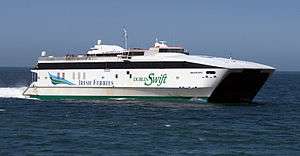Port of Cork


The Port of Cork is the main port serving the South of Ireland, County Cork and Cork City. It is the second busiest port in Ireland and offers all six shipping modes i.e. Lift-on Lift-off, Roll-on Roll-off, Liquid Bulk, Dry Bulk, Break Bulk and Cruise. In 2012 9.05m tonnes of freight was shipped through the Port of Cork.
Commercial Traffic
Vessels up to 90,000 tonnes deadweight (DWT) are capable of coming through the harbour entrance . As the shipping channels get shallower the farther inland one travels, access becomes constricted, and only vessels up to 60,000 DWT can sail above Cobh.
The Port of Cork provides pilotage and towage facilities for vessels entering Cork Harbour. All vessels accessing the quays in Cork City must be piloted and all vessels exceeding 130 metres in length must be piloted once they pass within 2.5 nautical miles (4.6 km) of the harbour entrance.
The Port of Cork has berthing facilities at Cork City, Tivoli, Cobh and Ringaskiddy. The facilities in Cork City are primarily used for grain and oil transport. Tivoli provides container handling, facilities for oil, livestock and ore and a roll on-roll off (Ro-Ro) ramp. Prior to the opening of Ringaskiddy Ferry Port, car ferries sailed from here; now, the Ro-Ro ramp is used by companies importing cars into Ireland. In addition to the ferry terminal, Ringaskiddy has a deep water port. .
The Port of Cork company is a commercial semi-state company responsible for the commercial running of the harbour as well as responsibility for navigation and berthage in the port. In 2011 the port had a turnover of €21.4 million and made pre-tax profits of €1.2 million.[1] This was down from a turnover of €26.4 million and profits of €5.4 million in 2006. Container traffic increased by 6% in 2011 when 156,667teus were handled at the Tivoli container facility, however this was down from a peak of 185,000 TEUs in 2006.[2] The 2006 figure saw the port at full capacity and the Port drew up plans for a new container facility capable of handling up to 400,000 teus per annum at Ringaskiddy recently. This was the subject of major objections and after an Oral Planning Hearing was held in 2008 the Irish planning board Bord Pleanala rejected the plan due to inadequate rail and road links at the location.[3]
There has been a steady increase in cruise ship visits to Cork Harbour over the past few years with 53 such ships visiting the port in 2011.[1] The vast majority of these cruise ships berth at Cobh's Deepwater Quay.
There are also a number of private berths around the harbour. These are usually associated with a particular industry. Such berths can be found in Whitegate, Passage West, Rushbrooke, Ringaskiddy and Haulbowline.
Berths
The port has over 10 berths, mostly privately owned.[4]
Passenger ferries

There is a ferry service to Roscoff operated by Brittany Ferries that operates between May and November. It operates from the Ro Ro facilities at Ringaskiddy Ferry Terminal (Cork).
There was previously a ferry service between Swansea and Cork, which ran between 1987 and 2006, and was briefly reinstated between 2010 and 2012.
References
Notes
Bibliography
- Phelan, Jack (1995). Ferries of Cork. Kilgetty, Pembrokeshire: Ferry Publications. ISBN 1871947332.
External links
Coordinates: 51°51′N 8°16′W / 51.850°N 8.267°W
